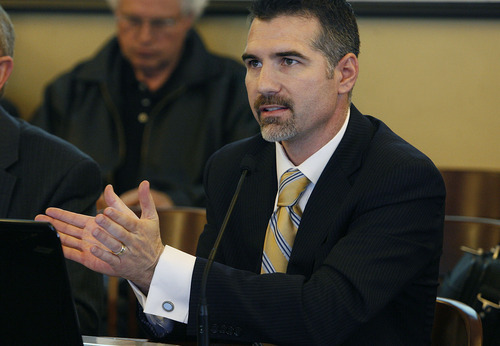This is an archived article that was published on sltrib.com in 2011, and information in the article may be outdated. It is provided only for personal research purposes and may not be reprinted.
Nuclear power in Utah could be water-wise economic development, adding 50 percent to the state's power generation while consuming just 1 percent of the current water supply, prospective power plant developer Aaron Tilton told lawmakers Monday.
Opponents countered that there's not enough water to keep pace with Utah's population growth as it is and that other power sources would make more efficient use of water.
Tilton, a former Utah County legislator, pitched his company's plan for a Green River plant to the Utah Senate's Natural Resources, Agriculture and Environment Committee 12 days after Gov. Gary Herbert, in his State of the State address, called for a "substantive debate and deliberation of whether there is a place for nuclear energy in Utah."
Tilton asserted that Blue Castle Energy's plant would siphon about 50,000 acre-feet per year from Utah's Colorado River allotment — water that he said now flows downstream to other states — while piling up per-gallon economic benefits far in excess of agriculture, the state's biggest water user.
"Water use in a nuclear power plant is very economic," Tilton said, calculating the power's dollar output at $127,569 per million gallons, to agriculture's $5,080. "The benefits are real in terms of jobs, tax base and labor income."
The envisioned plant would employ 825, compared with 22,500 farmworkers, while agriculture taps 82 percent of the state's diverted water. Per million gallons, he said, that's 50 nuclear-energy jobs to 13 farm jobs.
If approved by state and federal regulators and built by Blue Castle Energy, the plant would use river water rights leased from San Juan and Kane counties.
Skeptics told legislators that it would dry up other, better developments.
"We do not have the water resources," warned Ed Firmage Jr., who identified himself as a concerned citizen. He expects twin reactors such as those Tilton envisions to use 60,000 acre-feet, or as much as Washington County consumes.
With many climate models predicting less runoff in Utah's future, he said, whatever water goes to nuclear power would be lost from farms and urban development. "We have virtually no wiggle room."
"Nuclear uses four times as much water as natural gas," said Matt Pacenza, policy director for the Healthy Environment Alliance of Utah, citing industry figures. "Water resources are clearly critical to Utah's future."
Meanwhile, nuclear-energy consumers pay two to three times the rates that Utahns currently pay.
Pacenza said that prospect makes little sense when Utah is poised to exploit renewable energy at more reasonable rates.
Sen. Dennis Stowell, R-Parowan, foresees Utah's nuclear energy — like the wind power now coming online in southwestern Utah — being sold to higher-priced markets out of state while Utahns continue to enjoy cheaper rates from coal plants.



